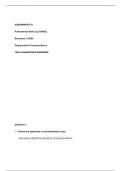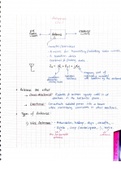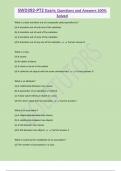Lesson 3
Global Migration
Global Migration Patterns: Intra-regional migration: Where are
migrants moving within Europe (EU)?
Intra-regional migration is migration between EU member states
EU nations – Spain, Cyprus, Croatia, France, Portugal, Malta,
Luxembourg, Republic of Ireland, Romania, Sweden, Slovenia, Slovakia,
Germany, Poland, Finland, Italy, Latvia, Bulgaria, Belgium, Lithuania,
Austria, Netherlands, Estonia, Denmark, Hungary, Greece, Czech Republic
International migration within the EU-28 is complex. In any one year not
only is there significant movement between the EU member states but
also between many non – EU countries and the EU. In 2012, 1.7 million
people residents in an EU country migrated to another EU country. And a
further 1. 7 million move to the EU from countries outside. Furthermore
2.7 million people migrated from the EU to a non-EU state. It can also be
explained by recent EU expansion which has increased the potential
number of migrants. The Czech Republic , Estonia, Latvia, Lithuania,
Malta, Poland, Cyprus , Hungary, Slovakia and Slovenia all joined the EU in
2004; Romania and Bulgaria in 2007; and Croatia in 2013.
Why migrate within Europe?
- Most of these countries have a relatively high proportion of
population of working ages groups seeking employment.
- They are also attracted by higher wages elsewhere within the EU
- The overriding motive for migration is economic e.g., Polish
accession to the EU in 2004 stimulated a new wave of immigration
from Poland to the UK.
- Polish migrants were attracted my greater employment
opportunities, higher wages, better living standards, and ease of
return, intended after perhaps two or three years of earning
- Retirement e.g., Spanish Costas
- Joining family members e.g., Poles in the UK
- Education e.g., university
- 1.2 million British live in EU
- 309k in Spain (highest), 255k in Republic of Ireland, 185k in France,
103k in Germany
- Many are self-sufficient retirees (difficult to get accurate data on
this)
- 2013/14 – UK spend £1.4 billion on pensions payments to people in
Europe
- Ease of travel – Schengen agreement link
In 2013, there were approximately 660,000 Poles living in the UK. In the
same year there were also 40,000 UK migrants living in Poland. Many of
these were business professionals; the potential business market in
Poland with attractive and open to innovation and inward investment.
Some were employed by MNCs and all were benefitting from the quality of
, Lesson 3
Global Migration
life in a country where the cost of living
is lower than the UK. Intra-regional
migration within the EU is also explained
by education, retirement, joining family
and return flows.
The Schengen Agreement (1995):
- Abolished many internal EU
borders
- Passport free movements
- 26 Schengen nations – 22 EU and 4 non-EU
- Not the UK or Republic of Ireland (free movement with republic of
Ireland – Common Travel Area)
- Borders can be reinstated for 10 days, if done immediately for
national security
What causes migration? – Push pull mechanism
Push factors Pull factors
Lack of jobs Job opportunities
Low wages Better wages
Poor standard of living Improved standard of living
Global Migration
Global Migration Patterns: Intra-regional migration: Where are
migrants moving within Europe (EU)?
Intra-regional migration is migration between EU member states
EU nations – Spain, Cyprus, Croatia, France, Portugal, Malta,
Luxembourg, Republic of Ireland, Romania, Sweden, Slovenia, Slovakia,
Germany, Poland, Finland, Italy, Latvia, Bulgaria, Belgium, Lithuania,
Austria, Netherlands, Estonia, Denmark, Hungary, Greece, Czech Republic
International migration within the EU-28 is complex. In any one year not
only is there significant movement between the EU member states but
also between many non – EU countries and the EU. In 2012, 1.7 million
people residents in an EU country migrated to another EU country. And a
further 1. 7 million move to the EU from countries outside. Furthermore
2.7 million people migrated from the EU to a non-EU state. It can also be
explained by recent EU expansion which has increased the potential
number of migrants. The Czech Republic , Estonia, Latvia, Lithuania,
Malta, Poland, Cyprus , Hungary, Slovakia and Slovenia all joined the EU in
2004; Romania and Bulgaria in 2007; and Croatia in 2013.
Why migrate within Europe?
- Most of these countries have a relatively high proportion of
population of working ages groups seeking employment.
- They are also attracted by higher wages elsewhere within the EU
- The overriding motive for migration is economic e.g., Polish
accession to the EU in 2004 stimulated a new wave of immigration
from Poland to the UK.
- Polish migrants were attracted my greater employment
opportunities, higher wages, better living standards, and ease of
return, intended after perhaps two or three years of earning
- Retirement e.g., Spanish Costas
- Joining family members e.g., Poles in the UK
- Education e.g., university
- 1.2 million British live in EU
- 309k in Spain (highest), 255k in Republic of Ireland, 185k in France,
103k in Germany
- Many are self-sufficient retirees (difficult to get accurate data on
this)
- 2013/14 – UK spend £1.4 billion on pensions payments to people in
Europe
- Ease of travel – Schengen agreement link
In 2013, there were approximately 660,000 Poles living in the UK. In the
same year there were also 40,000 UK migrants living in Poland. Many of
these were business professionals; the potential business market in
Poland with attractive and open to innovation and inward investment.
Some were employed by MNCs and all were benefitting from the quality of
, Lesson 3
Global Migration
life in a country where the cost of living
is lower than the UK. Intra-regional
migration within the EU is also explained
by education, retirement, joining family
and return flows.
The Schengen Agreement (1995):
- Abolished many internal EU
borders
- Passport free movements
- 26 Schengen nations – 22 EU and 4 non-EU
- Not the UK or Republic of Ireland (free movement with republic of
Ireland – Common Travel Area)
- Borders can be reinstated for 10 days, if done immediately for
national security
What causes migration? – Push pull mechanism
Push factors Pull factors
Lack of jobs Job opportunities
Low wages Better wages
Poor standard of living Improved standard of living










